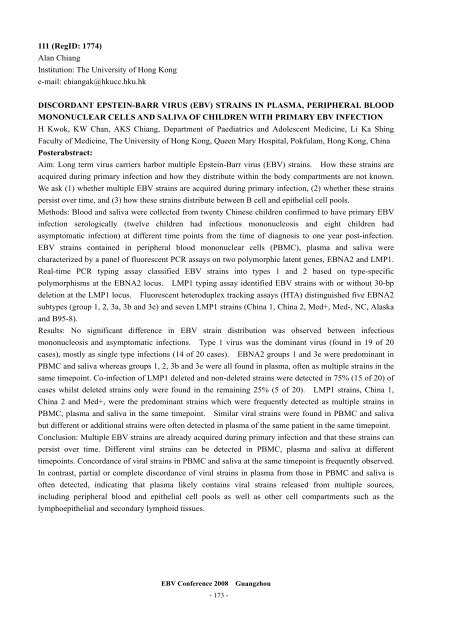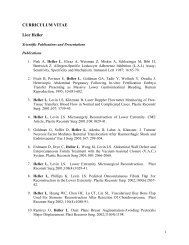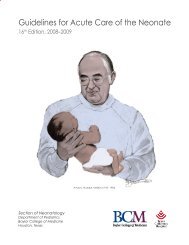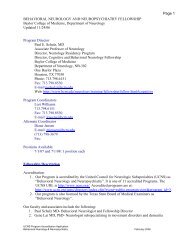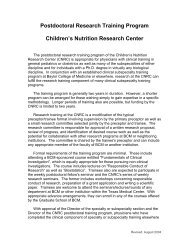EBV Conference 2008 Guangzhou - Baylor College of Medicine
EBV Conference 2008 Guangzhou - Baylor College of Medicine
EBV Conference 2008 Guangzhou - Baylor College of Medicine
Create successful ePaper yourself
Turn your PDF publications into a flip-book with our unique Google optimized e-Paper software.
111 (RegID: 1774)<br />
Alan Chiang<br />
Institution: The University <strong>of</strong> Hong Kong<br />
e-mail: chiangak@hkucc.hku.hk<br />
DISCORDANT EPSTEIN-BARR VIRUS (<strong>EBV</strong>) STRAINS IN PLASMA, PERIPHERAL BLOOD<br />
MONONUCLEAR CELLS AND SALIVA OF CHILDREN WITH PRIMARY <strong>EBV</strong> INFECTION<br />
H Kwok, KW Chan, AKS Chiang, Department <strong>of</strong> Paediatrics and Adolescent <strong>Medicine</strong>, Li Ka Shing<br />
Faculty <strong>of</strong> <strong>Medicine</strong>, The University <strong>of</strong> Hong Kong, Queen Mary Hospital, Pokfulam, Hong Kong, China<br />
Posterabstract:<br />
Aim: Long term virus carriers harbor multiple Epstein-Barr virus (<strong>EBV</strong>) strains. How these strains are<br />
acquired during primary infection and how they distribute within the body compartments are not known.<br />
We ask (1) whether multiple <strong>EBV</strong> strains are acquired during primary infection, (2) whether these strains<br />
persist over time, and (3) how these strains distribute between B cell and epithelial cell pools.<br />
Methods: Blood and saliva were collected from twenty Chinese children confirmed to have primary <strong>EBV</strong><br />
infection serologically (twelve children had infectious mononucleosis and eight children had<br />
asymptomatic infection) at different time points from the time <strong>of</strong> diagnosis to one year post-infection.<br />
<strong>EBV</strong> strains contained in peripheral blood mononuclear cells (PBMC), plasma and saliva were<br />
characterized by a panel <strong>of</strong> fluorescent PCR assays on two polymorphic latent genes, EBNA2 and LMP1.<br />
Real-time PCR typing assay classified <strong>EBV</strong> strains into types 1 and 2 based on type-specific<br />
polymorphisms at the EBNA2 locus. LMP1 typing assay identified <strong>EBV</strong> strains with or without 30-bp<br />
deletion at the LMP1 locus. Fluorescent heteroduplex tracking assays (HTA) distinguished five EBNA2<br />
subtypes (group 1, 2, 3a, 3b and 3e) and seven LMP1 strains (China 1, China 2, Med+, Med-, NC, Alaska<br />
and B95-8).<br />
Results: No significant difference in <strong>EBV</strong> strain distribution was observed between infectious<br />
mononucleosis and asymptomatic infections. Type 1 virus was the dominant virus (found in 19 <strong>of</strong> 20<br />
cases), mostly as single type infections (14 <strong>of</strong> 20 cases). EBNA2 groups 1 and 3e were predominant in<br />
PBMC and saliva whereas groups 1, 2, 3b and 3e were all found in plasma, <strong>of</strong>ten as multiple strains in the<br />
same timepoint. Co-infection <strong>of</strong> LMP1 deleted and non-deleted strains were detected in 75% (15 <strong>of</strong> 20) <strong>of</strong><br />
cases whilst deleted strains only were found in the remaining 25% (5 <strong>of</strong> 20). LMP1 strains, China 1,<br />
China 2 and Med+, were the predominant strains which were frequently detected as multiple strains in<br />
PBMC, plasma and saliva in the same timepoint. Similar viral strains were found in PBMC and saliva<br />
but different or additional strains were <strong>of</strong>ten detected in plasma <strong>of</strong> the same patient in the same timepoint.<br />
Conclusion: Multiple <strong>EBV</strong> strains are already acquired during primary infection and that these strains can<br />
persist over time. Different viral strains can be detected in PBMC, plasma and saliva at different<br />
timepoints. Concordance <strong>of</strong> viral strains in PBMC and saliva at the same timepoint is frequently observed.<br />
In contrast, partial or complete discordance <strong>of</strong> viral strains in plasma from those in PBMC and saliva is<br />
<strong>of</strong>ten detected, indicating that plasma likely contains viral strains released from multiple sources,<br />
including peripheral blood and epithelial cell pools as well as other cell compartments such as the<br />
lymphoepithelial and secondary lymphoid tissues.<br />
<strong>EBV</strong> <strong>Conference</strong> <strong>2008</strong> <strong>Guangzhou</strong><br />
- 173 -


